13 Jun High Wattage – AC/DC’s Marshall amps through the years (Work in Progress – UPDATED: Back in Black era uncovered)
Main Research: André Kozuma
Edits and additional info, SoloDallas
_______________________________
So, hello again everyone! 🙂
Here I am again with another article.
This all is mostly things we already know, but I felt that we needed a place to put it all together and make it easier to consult rather than have to search though all the other pages to find the info on the comments or that sort of thing.
What I plan to do is a real Index for everything AC/DC related (gear-wise), but mostly the amps. Perhaps we can cover all of AC/DC’s history, but I can’t do this alone. I would like to ask every member of this community a little help. If you find any bit of info, good pics, videos, whatever it is, that you think it’s interesting, share with us, so we can oficially post it here.
So, let’s start with the amps.
Early Years – High Voltage, TNT, Dirty Deeds Done Dirt Cheap (1973 – 1976)
A few pics:
 Malcolm during a recording session – Note how the cab is turned towards the opposite direction. Interesting.
Malcolm during a recording session – Note how the cab is turned towards the opposite direction. Interesting.
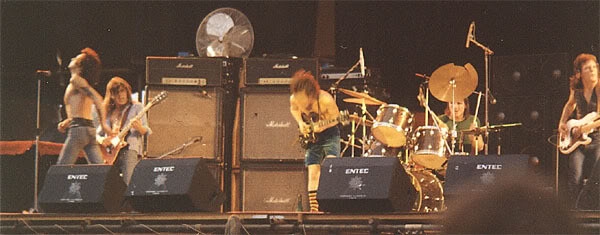 August 29th, 1976 – Thameside Arena, Reading, England
August 29th, 1976 – Thameside Arena, Reading, England
 “Baby Please Don’t Go” video screenshot (from Family Jewels Disc 1)
“Baby Please Don’t Go” video screenshot (from Family Jewels Disc 1)
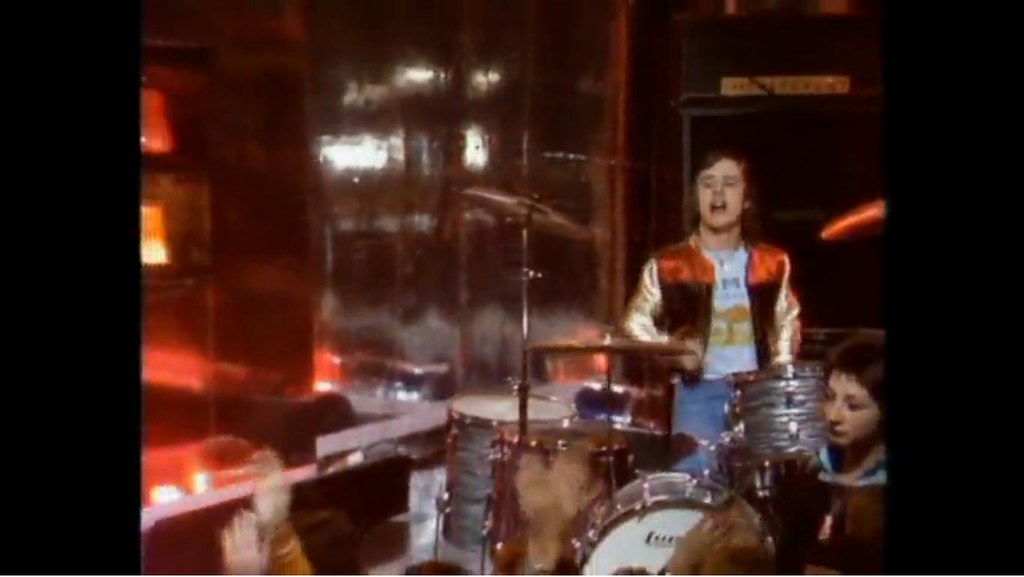 Same as above. This is Angus’ amp.
Same as above. This is Angus’ amp.
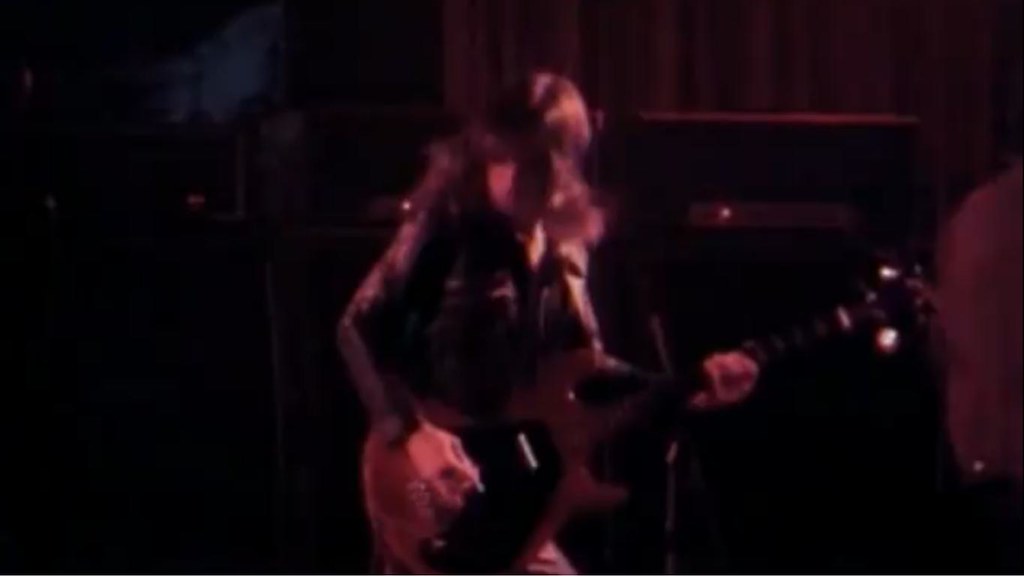 “Show Business” video (Family Jewels Disc 1) – Angus’ amp behind Mark Evans
“Show Business” video (Family Jewels Disc 1) – Angus’ amp behind Mark Evans
Sound examples:.
Baby Please Don’t Go/ Show Business (Found on the Family Jewels disc 1)
httpv://www.youtube.com/watch?v=jru9irA9D9U
Live Wire (July 26th, 1976 at the Marquee Club, London, England)
httpv://www.youtube.com/watch?v=DXNsARuQGsg
Soul Stripper (July 26th, 1976 at the Marquee Club, London, England)
httpv://www.youtube.com/watch?v=ENjYEjXGStE
Rock n Roll Singer (July 31, 1976 at Barbarellas, Birmingham, England)
httpv://www.youtube.com/watch?v=Q1Ly4WzkpiU
Live Wire (same show as above)
httpv://www.youtube.com/watch?v=yWCNwGQ4sHA
No big secrets here, really. It’s obvious that when the boys were just starting, they didn’t have many resources and had to use what was available to them.
Their tone here is more organic, warmer, bluesier and fatter. They were clearly using early 70’s metal-face Super Leads (1959). End of discussion.
NOTE: Malcolm also could have been using Super Basses (1992).
We assume these were the amps used to record the albums too.
Let There be Rock era (Late 1976 – 1977)
 Picture showing AC/DC with the “rocker switch” amps and new cabs. (September 23rd, 1976 – Musikhalle Grosser Saal, Hamburg, Germany)
Picture showing AC/DC with the “rocker switch” amps and new cabs. (September 23rd, 1976 – Musikhalle Grosser Saal, Hamburg, Germany)
Note: What a luck! I randomly chose this image to open this section and turns out that this is the earliest pic I could find with the new amps! This means they got them between August and September 1976. The last pic with the old JMPs is the August 29th gig.
After the release of the internetional version of “High Voltage”, (featuring tracks from the australian High Voltage and TNT), AC/DC received brand new “Rocker Switch” JMP heads from Marshall, as well as brand new cabs. Now, here is where things start to get tricky. We have two kinds of amps being used here: the Master Volume amps (2203/ 2204) and the non-Master Volume amps (1959/ 1987). There’s no apparent difference between them other than the number of inputs. So, let’s take a closer look at the pics.
 Same gig as above, different angle. Here we see that Malcolm and Angus are using MV heads. Angus’ one seems to be a mixed up one (toggle switches, but new headbox and logo).
Same gig as above, different angle. Here we see that Malcolm and Angus are using MV heads. Angus’ one seems to be a mixed up one (toggle switches, but new headbox and logo).
 Unknown show, but It’s crystal clear. Two inputs. Angus is using at least one MV head here.
Unknown show, but It’s crystal clear. Two inputs. Angus is using at least one MV head here.
September 30, 1976 — Multihalle, Mannheim, Germany
The bottom head is, again, a MV. The pic is too blurry to identify the other one.
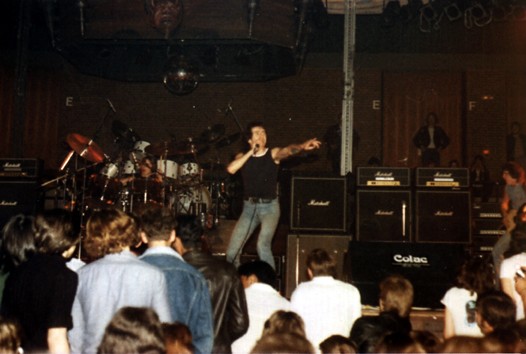 April 7th, 1977 Stadthalle, Offenbach am Main, Germany
April 7th, 1977 Stadthalle, Offenbach am Main, Germany
Both amps on Angus’ side are MV, seemingly.
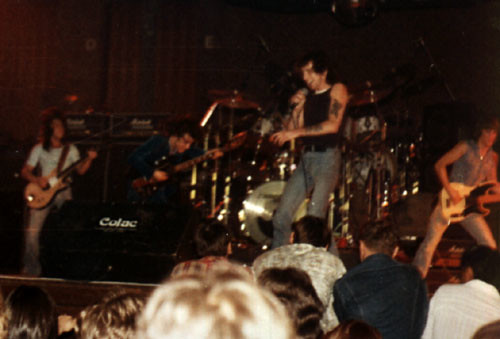 Same gig as above. It’s hard to see, but I believe Malcolm is using MV amps too (note how there’s black, followed by gold – meaning 2 plastic inputs and the plain metal panel)
Same gig as above. It’s hard to see, but I believe Malcolm is using MV amps too (note how there’s black, followed by gold – meaning 2 plastic inputs and the plain metal panel)
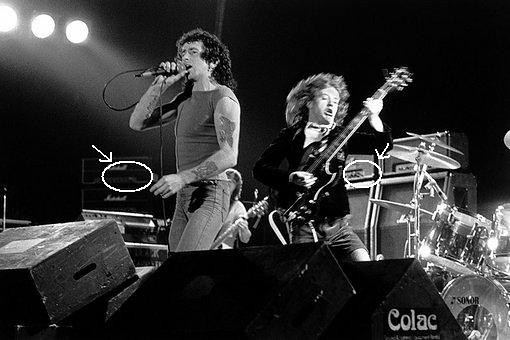 April 19th, 1977 — Odd Fellow, Copenhagen, Denmark
April 19th, 1977 — Odd Fellow, Copenhagen, Denmark
The ones in the back are hard to see, but the one close to Angus clearly only has two inputs (what you see is a shadow). Beside it, we have the “mixed-up” JMP once again.
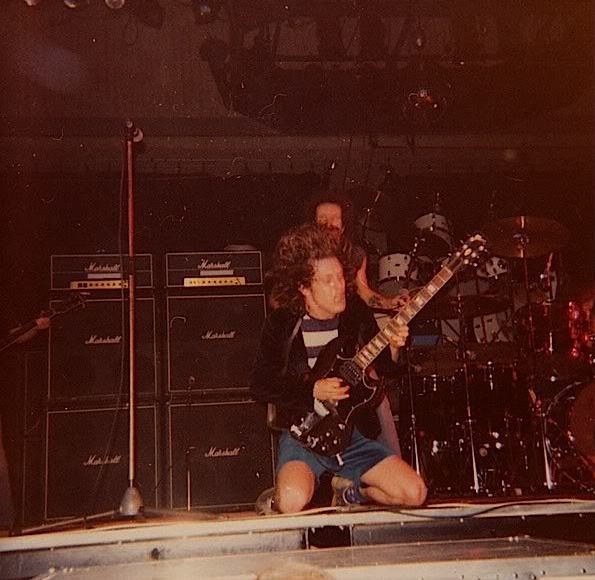 April 21st, 1977 Olympen, Lund, Sweden
April 21st, 1977 Olympen, Lund, Sweden
The mixed-up MV again and…
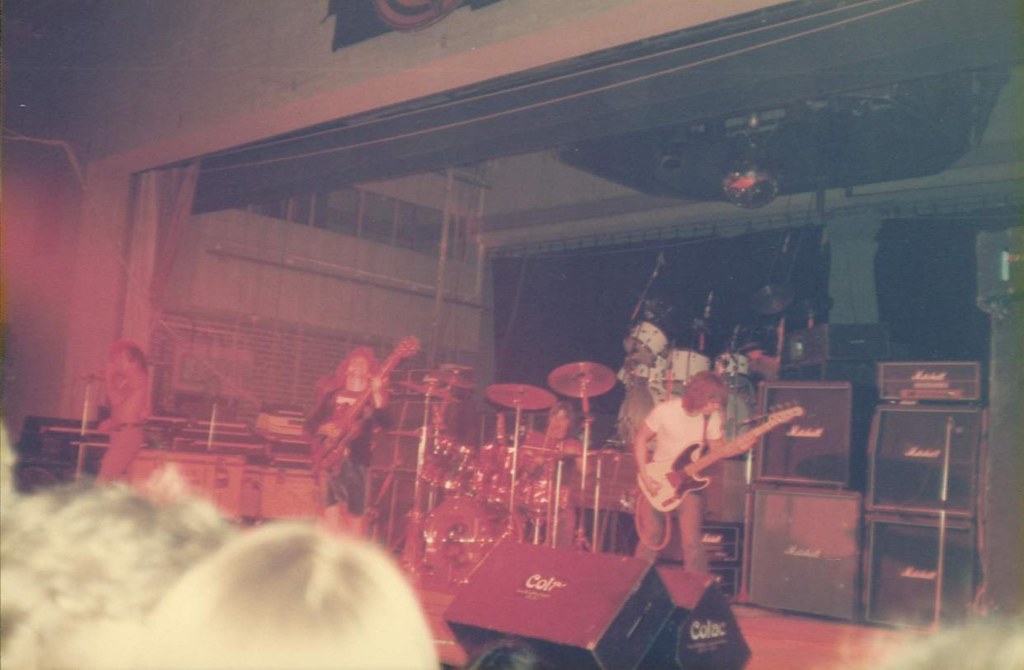 On Angus’ side, there’s another MV.
On Angus’ side, there’s another MV.
NOTE: Thanks to powersurge for the next two pics:
 August 29th, 1977 – The Whiskey A Go-Go, Los Angeles, CA, USA
August 29th, 1977 – The Whiskey A Go-Go, Los Angeles, CA, USA
From left to right: A MV (probably) and the “mixed-up” JMP MV on Malcolm’s side and an early 70’s JMP on Angus’s side (rest is out of view).
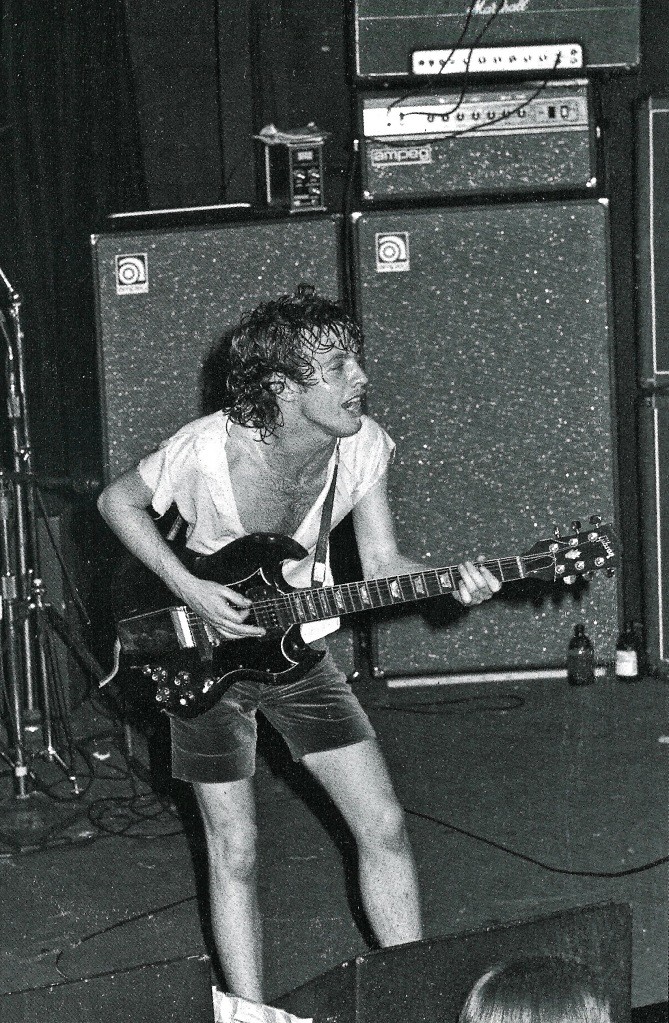 An interesting pic, but not because of the amp. 😛
An interesting pic, but not because of the amp. 😛
Looks familiar?
 Oh yeah! \m/ LET THERE BE ROCK BABY! A Schaffer-Vega Diversity!
Oh yeah! \m/ LET THERE BE ROCK BABY! A Schaffer-Vega Diversity!
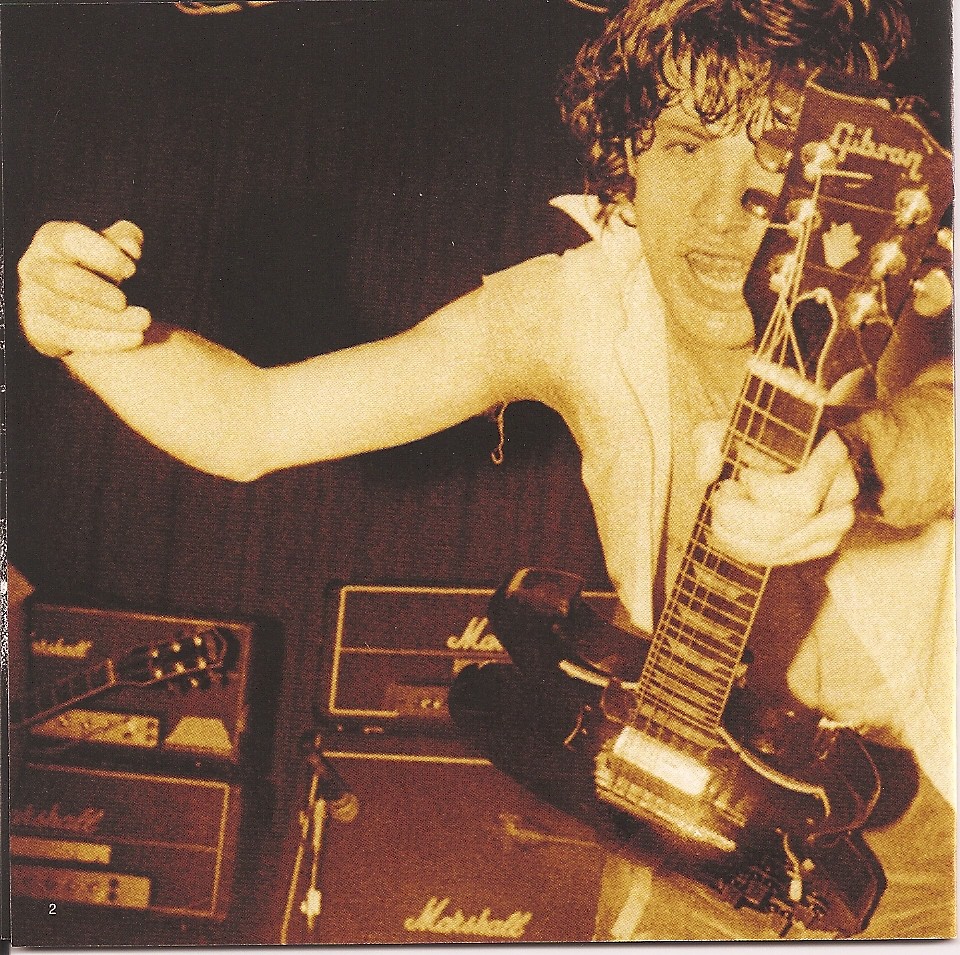 And a really great pic from The Old Waldorf In San Francisco (September 2nd or 3rd, 1977). We have a MV head there. And a damaged non-MV (apparently a toggle switch version – note the smaller “Marshall” logo). Considering the previous pics, the amp behind Angus is the same mixed-up 2203 with toggle switches seen earlier.
And a really great pic from The Old Waldorf In San Francisco (September 2nd or 3rd, 1977). We have a MV head there. And a damaged non-MV (apparently a toggle switch version – note the smaller “Marshall” logo). Considering the previous pics, the amp behind Angus is the same mixed-up 2203 with toggle switches seen earlier.
I’ve been wondering what those “white block” things under the logo were. Tyler suggested that they are just pieces of tape where the Young brothers wrote down their amp settings. Either that, or it’s just to mark “Angus” or “Malcolm”. Both explanations seem really plausible.
Here is a new pic (found by powersurge):
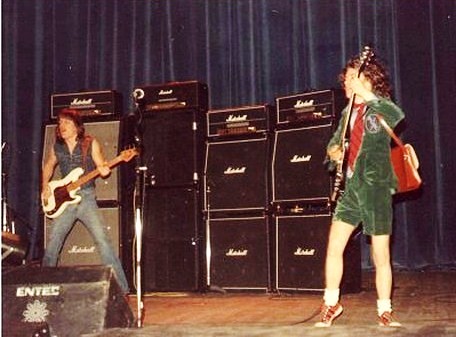 July 7th, 1976 – Lyceum Ballroom, London, England (date must be wrong. They can’t have the new JMPs here if they didn’t use them on the Reading show in August 29th, 1976 – There’s also no audio recording, what makes me even more suspicious)
July 7th, 1976 – Lyceum Ballroom, London, England (date must be wrong. They can’t have the new JMPs here if they didn’t use them on the Reading show in August 29th, 1976 – There’s also no audio recording, what makes me even more suspicious)
You can see the tape on the early 70’s JMP too, so that means it has nothing to do with “identifying” the new amps, as I thought before (I feel kinda dumb now – hehe)
By the way, is it just me, or those cabs behind Mark look HUGE?
 This one is from the Let There be Rock music video. It’s clearly a MV (Two inputs). So… This is the amp used to record the album? Well… It must be there for a reason.
This one is from the Let There be Rock music video. It’s clearly a MV (Two inputs). So… This is the amp used to record the album? Well… It must be there for a reason.
 October 4th, 1977 Markthalle, Hamburg, Germany
October 4th, 1977 Markthalle, Hamburg, Germany
There we see a non-MV JMP “rocker switch”. The one on the right side is the mixed-up 2203. I do believe the other head is a non-MV too. Why? Malcolm had at least two of them at this point (see the Golders Green image below).
 The next few pics are from the Golders Green Hippodrome, October 27th, 1977. Here we have a blurry shot on Malcolm’s amps (click on the image to make it bigger). We have a (almost) clear view of two 4-input “rocker switch” amps!
The next few pics are from the Golders Green Hippodrome, October 27th, 1977. Here we have a blurry shot on Malcolm’s amps (click on the image to make it bigger). We have a (almost) clear view of two 4-input “rocker switch” amps!
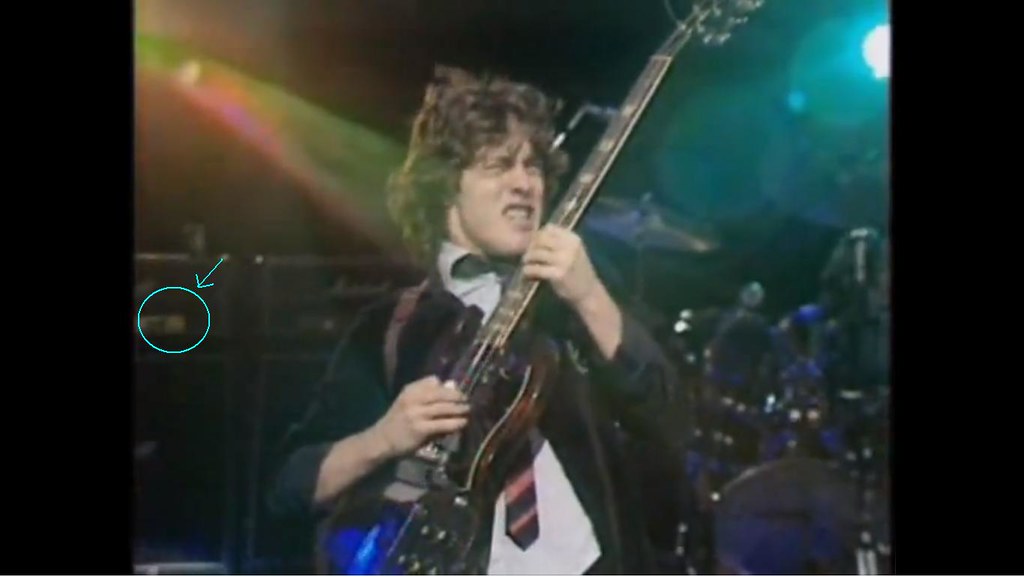 What do we have here? A MV head being used by Malcolm. Is that the mixed-up JMP next to it it? 😛
What do we have here? A MV head being used by Malcolm. Is that the mixed-up JMP next to it it? 😛
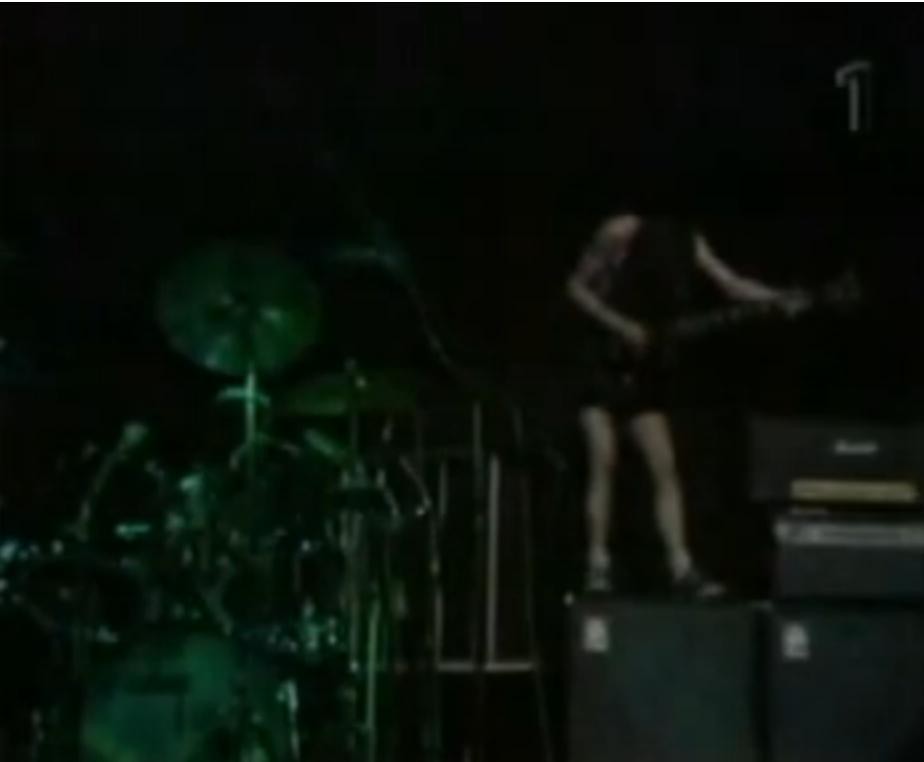 Looky there! An old toggle switch JMP! A backup maybe?
Looky there! An old toggle switch JMP! A backup maybe?
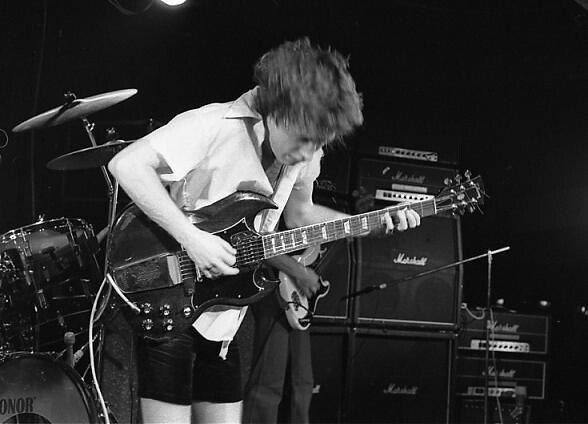 December 4th, 1977 Electric Ballroom, Milwaukee, WI, USA
December 4th, 1977 Electric Ballroom, Milwaukee, WI, USA
From up to below: a non-MV JMP with toggle switches (maybe one of the backups), then a MV JMP and A non-MV head (seemingly unused). Last one is impossible to tell.
 A partial view of Malcolm’s amps: that old damaged early 70’s non-MV JMP and a MV under it.
A partial view of Malcolm’s amps: that old damaged early 70’s non-MV JMP and a MV under it.
Sound examples:
Let’s make it in chronological order this time. Why? You will find out soon enough.
Problem Child (December 5th, 1976 at Melbourne, Australia)
httpv://www.youtube.com/watch?v=JMAZdPRkPr0
Oh dear… Watch the video carefully (especially at 0:55 – 1:04). Lots of MV Marshalls in this one! 😀
Jailbreak (January 30th, 1977 at Sydney, Australia)
httpv://www.youtube.com/watch?v=A2AvaqoM5Rk
The sound got a lot edgier, more overdriven and brighter. This, my friends, is the pure sound of the 2203.
Now, listen carefully to these two clips:
Problem Child (August 22nd, 1977 at the Agora Ballroom, Cleveland)
httpv://www.youtube.com/watch?v=FPBG3ZvaCZE
[similar to the Melbourne one, right? Now, the next one]
Problem Child (August 24th, 1977 at the Palladium, New York)
httpv://www.youtube.com/watch?v=NQuuGvZ6m5M
Apart from the pitch difference (the tape was probably sped up), and the acoustics, did you notice a difference in the “texture” of the sound? Yes? Brighter, tighter high end, sharper? What happened between these two shows?
The Schaffer-Vega Diversity System! That’s right! Cool, huh? 😉
But also note that the difference is pretty much “subtle”. This is because, at that point, Angus was mainly using the rear output (Just look at the Whiskey a Go-Go pics again and you’ll see that there’s no sign of cable plugged into the front). This means there was no boost, only the compressor.
Live Wire (September 3rd, 1977 – The Old Waldorf, San Francisco) – Listen to Malcolm’s tone (with the non-MV/ MV configuration)
httpv://www.youtube.com/watch?v=Gd8CUPxWsIg
And, just for a good measure, the Golders Green performance (October 27th, 1977):
httpv://www.youtube.com/watch?v=FEe-Q0–nVs
Conclusions for the Let There be Rock era are:
- In 1976, the Young brothers started using “rocker switch” JMP Marshalls. MVs seemed to be used more, at first instance. This made their sound brighter and more aggressive;
- Early 70’s heads are still present through 1976 and 1977, probably more as backups;
- The LTBR album was probably recorded with the 2203 and 2204 (
and an yet to be identified boostPretty much demonstrated as the album additional boost was a solid-state distortion likely made by some solid state preamp gone into wanted distortion; microphone console pre-amp, etc.; see and listen to this); - Live performances were done with half step down tuning (or close to that – hehe). 😛
- The Schaffer Vega Diversity System tightened up the tone of the guitars, enhanced the high end frequencies and added a little more drive (August 1977 onwards);
- At first instance, only the rear output of the SVDS was being used. Then, at some point, Angus started to use the front input instead, giving him an additional boost.
- It is important to note that ONLY ANGUS was using the Schaffer Vega Diversity System. Malcolm continued using only cables, up to the 80’s (maybe?) when they switched to a different wireless;
- A mix of MV and non-MV amps was used in the last half of 1977.
Powerage era (1978)
The 1978 tour started on April 26th, most likely right after the recording sessions of the Powerage album. Lets start with a very well known show:
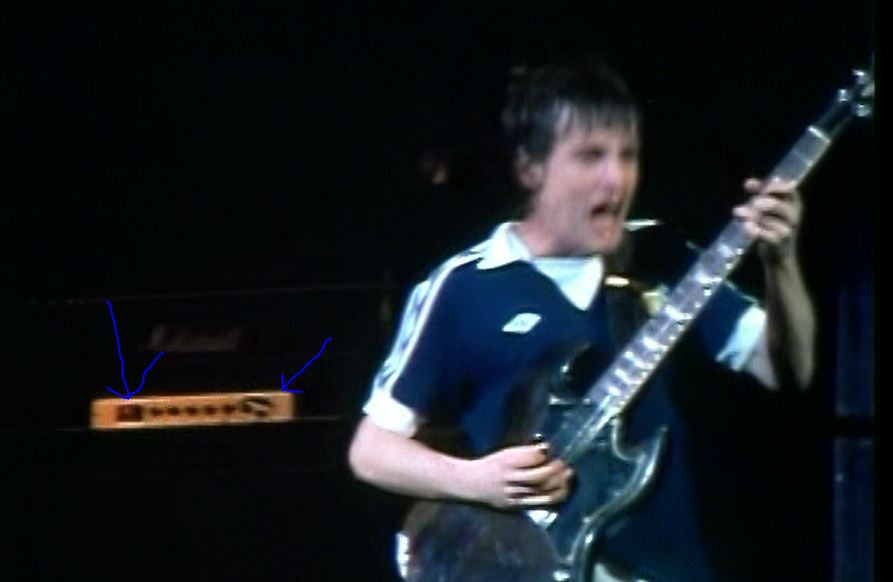 (April 30th, 1978 – The famous concert at the Apollo, Glasgow, Scotland) – Screenshots taken by 06AngusSG
(April 30th, 1978 – The famous concert at the Apollo, Glasgow, Scotland) – Screenshots taken by 06AngusSG
Clearly a MV being used by Angus. This seems to be the far right stack.
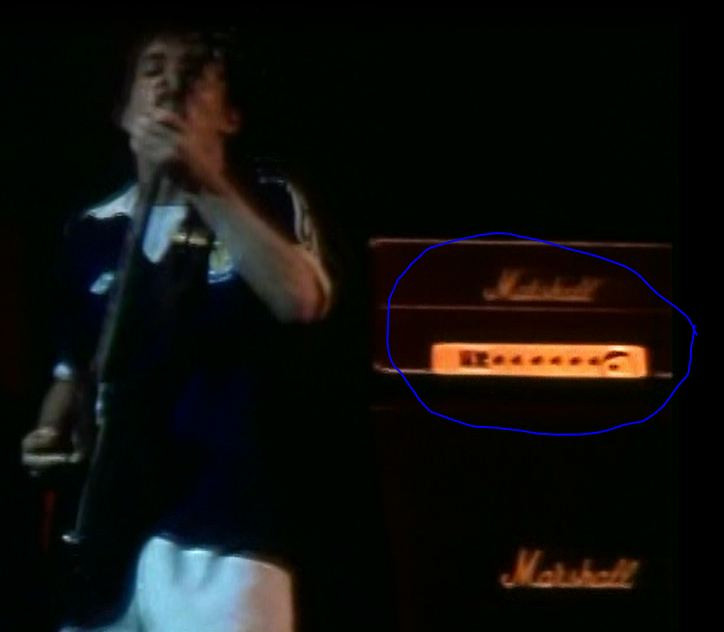 This is the stack that is closest to Phil (in a total of 4)
This is the stack that is closest to Phil (in a total of 4)
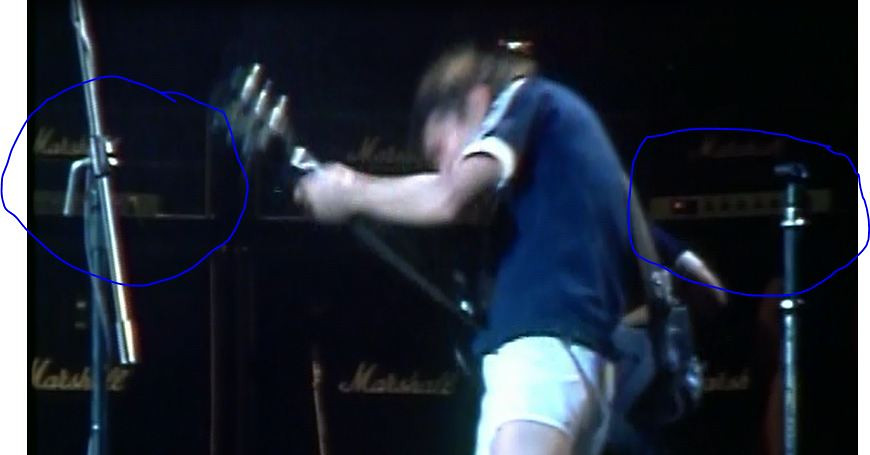 The second stack and, as seen before, the fourth stack (2 inputs each).
The second stack and, as seen before, the fourth stack (2 inputs each).
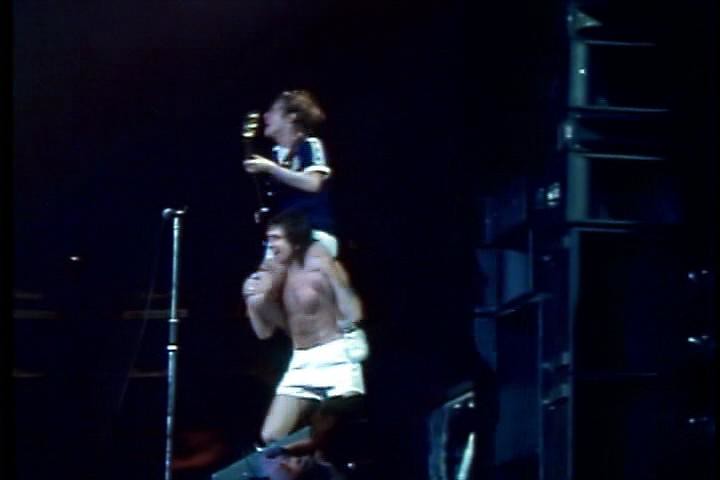
Behind the mic stand, you can see the panel of the 3rd head. Looks like it has only 2 inputs.
Now, Malcolm’s side:
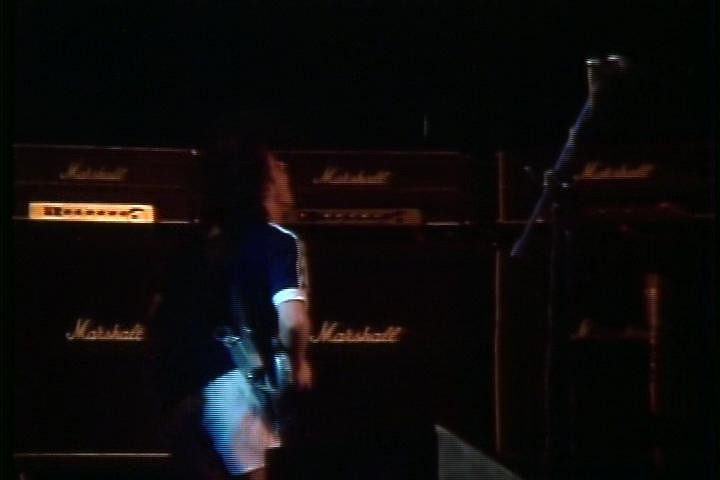 The two far left stacks. Do I need to say anything?
The two far left stacks. Do I need to say anything?
 Hard to see, but here we have more two MVs, apparently.
Hard to see, but here we have more two MVs, apparently.
“If You Want Blood” live album = Marshall JMP Master Model 100w Lead #2203. CASE CLOSED.
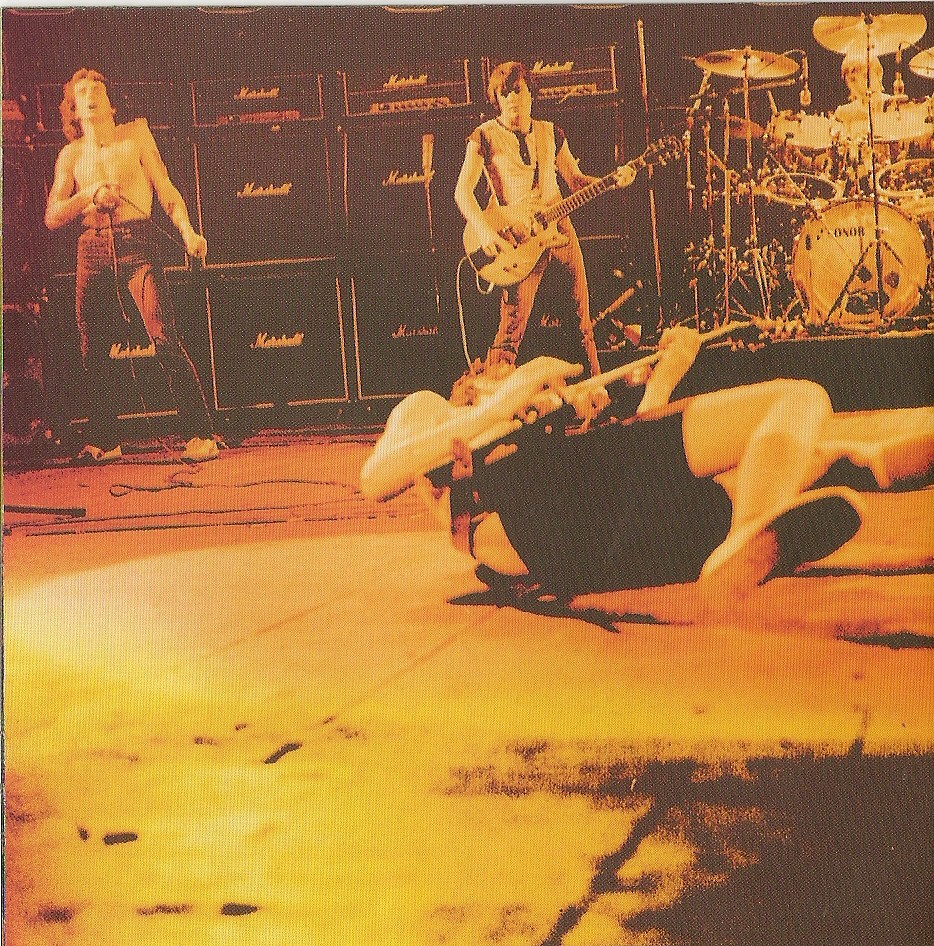
It’s too blurry… But considering the Glasgow gig, I assume all of them are MVs.
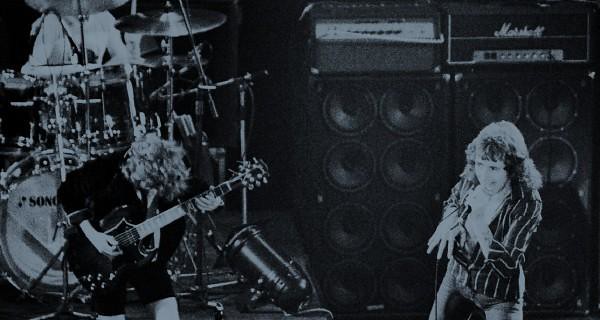 May 6th, 1978 Free Trade Hall, Manchester, England
May 6th, 1978 Free Trade Hall, Manchester, England
That’s certainly a 2203 up there
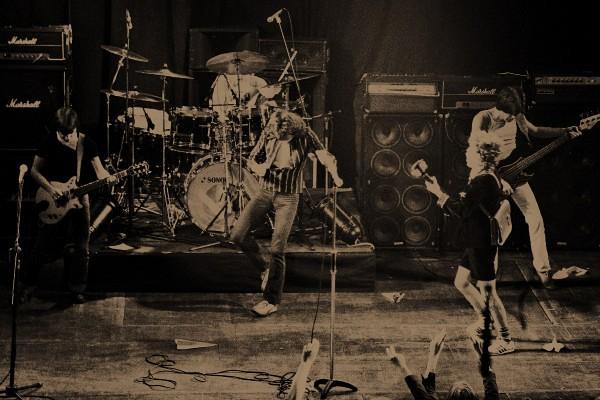 on Malcolm’s amp, I see the cable jack creating a straight shadow. This means it’s the plain metal panel (2203).
on Malcolm’s amp, I see the cable jack creating a straight shadow. This means it’s the plain metal panel (2203).
Now, you are going to have a little surprise…
 July 23rd, 1978 Oakland Coliseum, Oakland, CA, USA
July 23rd, 1978 Oakland Coliseum, Oakland, CA, USA
(Autographed pic. How cool is that?)
Back to the subject… What do we have here? non-MV heads?
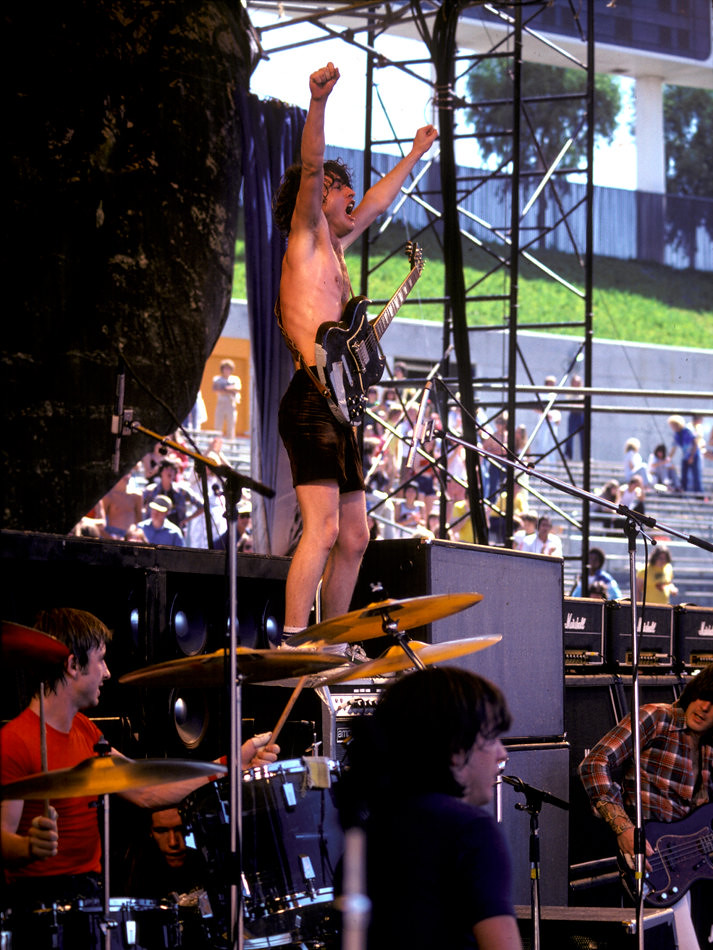 Angus is using non-MV heads too?
Angus is using non-MV heads too?
 August 21st, 1978 – Paradise Theater, Boston, MA, USA
August 21st, 1978 – Paradise Theater, Boston, MA, USA
The “If You Want Blood” back cover art. You can see a non-MV at the left corner
 Septermber 6th, 1978 – Midnight Special
Septermber 6th, 1978 – Midnight Special
(No advertising allowed!)
non-MV “secret” amp.
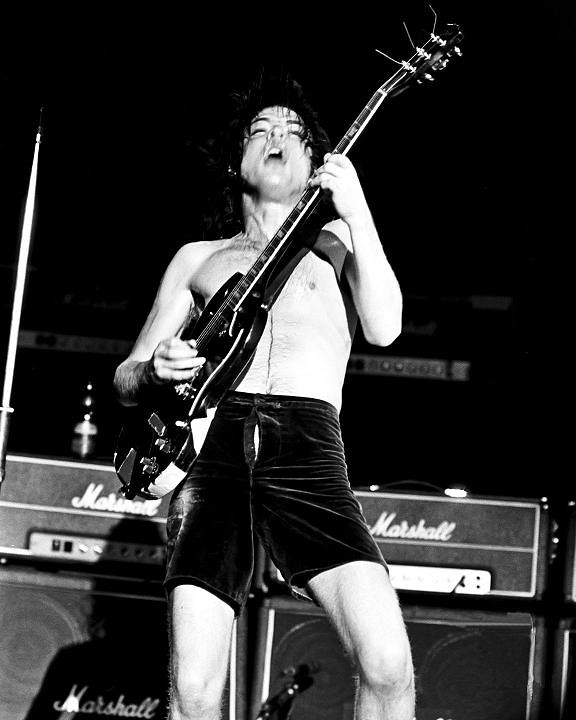 September 13rd, 1978 – Royal Oak Theatre, Royal Oak, MI, USA
September 13rd, 1978 – Royal Oak Theatre, Royal Oak, MI, USA
non-MV heads. Wait! Isn’t that a 2203 on the background? Yeah. It is. But it’s a Thin Lizzy’s amp.
This means the Young brother went back to the non-MV heads around June 1978? Seemingly, yes.
Note that the inputs are the black plastic ones. Marshall started to make them with those around 1978, so they are brand new amps.
The cabs might be new ones too. In this case, they could be equipped with G12-65 speakers.
Look at the above pic again. We can see the speakers through the grill cloth.
Now, compare them to those:
Looks like it’s the second one, isn’t it?
Let’s move on.
 October 28th, 1978 – Essex University, Colchester, England
October 28th, 1978 – Essex University, Colchester, England
Here we have a problem… MV heads again?
Wait, wait… So… They went back to the non-MV heads, and used MV on this show?
It seems that the venue was too small for the Super Leads, so they used the Master Models instead.
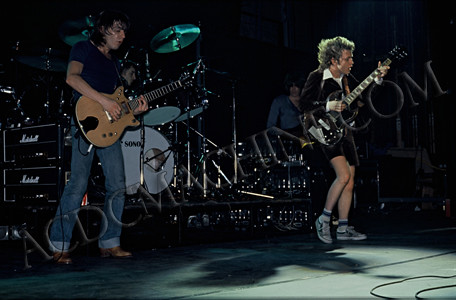 November 20th, 1978 – Gota Lejon, Stockholm, Sweden
November 20th, 1978 – Gota Lejon, Stockholm, Sweden
A proof that they definetly went back to the non-MVs. It’s the last show of 1978.
Sound examples:
The early-1978 sound with only 2203 amps is, of course, heard on the “If You Want Blood” album.
Problem Child (April, 30th, 1978 – the Apollo Theatre, Glasgow, Scotland)
httpv://www.youtube.com/watch?v=NelzxuM040M&feature=related
UPDATE: Sound evidences and experiments seem to indicate that Celestion G12-65 speakers were used at Glasgow.
For a good measure, let’s hear a lower quality bootleg:
Problem Child (May 5, 1978 – Mayfair, Newcastle, England)
httpv://www.youtube.com/watch?v=PiqsOOe-p4o
Now, listen to this:
Problem Child (September 10, 1978 – Veterans Memorial Auditorium, Columbus, OH, USA)
httpv://www.youtube.com/watch?v=WtzG71ZZWY0&feature=related
Did you notice a difference?
It’s even brighter, with a stronger attack and definitely more “metallic”.
Perhaps, another proof that they started using G12-65 speakers.
Problem Child (October 23rd, 1978 – Vereeniging Hall, Nijmegan, Holland)
httpv://www.youtube.com/watch?v=KBckpu_Zvy4&feature=related
Same thing as above.
Problem Child (October 28th, 1978 – Essex University, Colchester, England)
httpv://www.youtube.com/watch?v=eY9H0s5sph0
I can tell the amps were relatively low. It doesn’t sound that full. Perhaps, the room was too small for the non-MV 100 watters and that’s why they used the Master Models, so they could still drive the amps at lower volumes.
You can hear it’s really really bright too.
Enough of Problem Child? Alright:
Bad Boy Boogie (September 10, 1978 – Veterans Memorial Auditorium, Columbus, OH, USA)
httpv://www.youtube.com/watch?v=PRPCfkoGqlQ&feature=related
Acid sounding guitar, don’t you think?
Sin City (September 6, 1978 — Midnight Special, XX, USA)
httpv://www.youtube.com/watch?v=MAb0kSq9jKU&feature=related
The pic up there tells us they used non-MVs here.
Sin City (August 8, 1978 – Atlantis Record Bar Convention, Nashville, TN, USA)
httpv://www.youtube.com/watch?v=3mfdP9t2vV0
I have a feeling that this wasn’t a big venue.
All this drive implies that MVs are being used.
Is it just me or it sounds a lot like the studio version tone?
This makes me wonder if they didn’t have the G12-65 right from the beginning of the tour (CONFIRMED NOW! :P).
Still… I’m not sure if they were available back then… And the album version is kind of smoother (And so is the Glasgow concert)… Well… This is just for us to think.
UPDATE: I spent some hours listening to those 1978 gigs again and I think I figured it out. Listen to these:
Whole Lotta Rosie (April, 30th, 1978 – the Apollo Theatre, Glasgow, Scotland)
httpv://www.youtube.com/watch?v=5oEtlLRWHmg
Whole Lotta Rosie (May 5, 1978 – Mayfair, Newcastle, England)
httpv://www.youtube.com/watch?v=ytR-eXLRK2A
Low quality but… We don’t have many bootlegs from this time period.
Alright. NOW:
Whole Lotta Rosie (August 8, 1978 – Atlantis Record Bar Convention, Nashville, TN, USA)
httpv://www.youtube.com/watch?v=oHctaQwlsxI
Whole Lotta Rosie (October 28th, 1978 – Essex University, Colchester, England)
httpv://www.youtube.com/watch?v=qQWJog7eYqY
Those two last ones sound pretty much alike, don’t they?
Well… We know that in Colchester only 2203 heads were used. So, this confirms our theory that they still used them for smaller venues.
Whole Lotta Rosie (October 23rd, 1978 – Vereeniging Hall, Nijmegan, Holland)
httpv://www.youtube.com/watch?v=maWnLrewBhs
The texture here is different. It’s more… “grainy”? Well… This tone change matches the photo evidences. non-MV were preferred for bigger venues.
Conclusions:
- Standard tuning (or something close) was used on that year;
- First shows done entirely with Marshall Master Model (2203) amps;
- Therefore, the Powerage also was recorded with MVs (and it’s documented here);
- AC/DC started using Celestion G12-65 speakers;
- They switched to non-MV heads in mid-1978, except at smaller venues (like the Colchester gig).
Highway to Hell era (1979 – early 1980)
June 3rd, 1979 – John ODonnell Stadium, Davenport, IA, USA
The first different thing we notice here is the JMP combo. It’s either a 2104 (MV) or a 2187 (non-MV)
1979. A very important year for AC/DC. This is when they really started to get big in the United States, breaking into the charts with the now classic Highway to Hell album. This would aslo be, sadly, their last tour with the great late Bon Scott. Well, let’s get right into it!
Although the tour started on May 1st, we don’t have many images available. So, our first images are from June.
 Too blurry to see, but these are most likely non-MVs on Angus side (3 of them – last one is out of view)
Too blurry to see, but these are most likely non-MVs on Angus side (3 of them – last one is out of view)
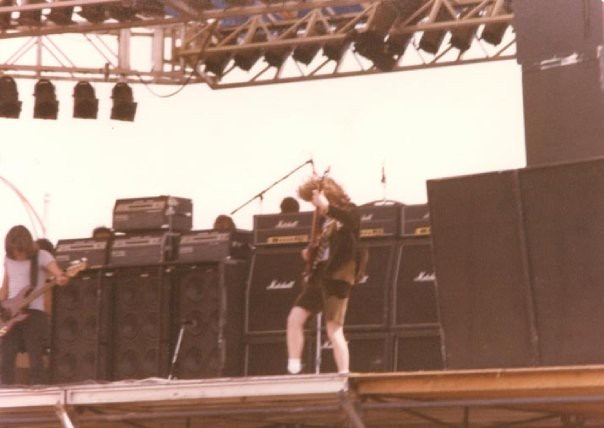 Different angle. There is the third stack.
Different angle. There is the third stack.
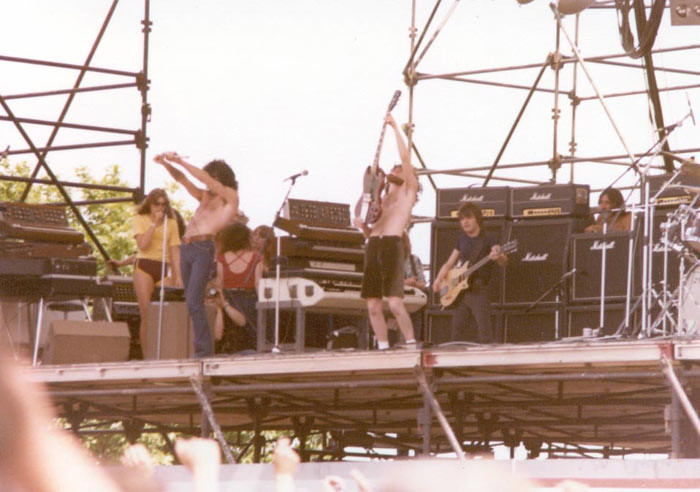 Malcolm’s amps are non-MVs too. He has four amps here instead (if we count the combo)
Malcolm’s amps are non-MVs too. He has four amps here instead (if we count the combo)
 July 13rd, 1979 — Rijnhallen, Arnhem, Holland
July 13rd, 1979 — Rijnhallen, Arnhem, Holland
Malcolm firing up his non-MV Marshalls
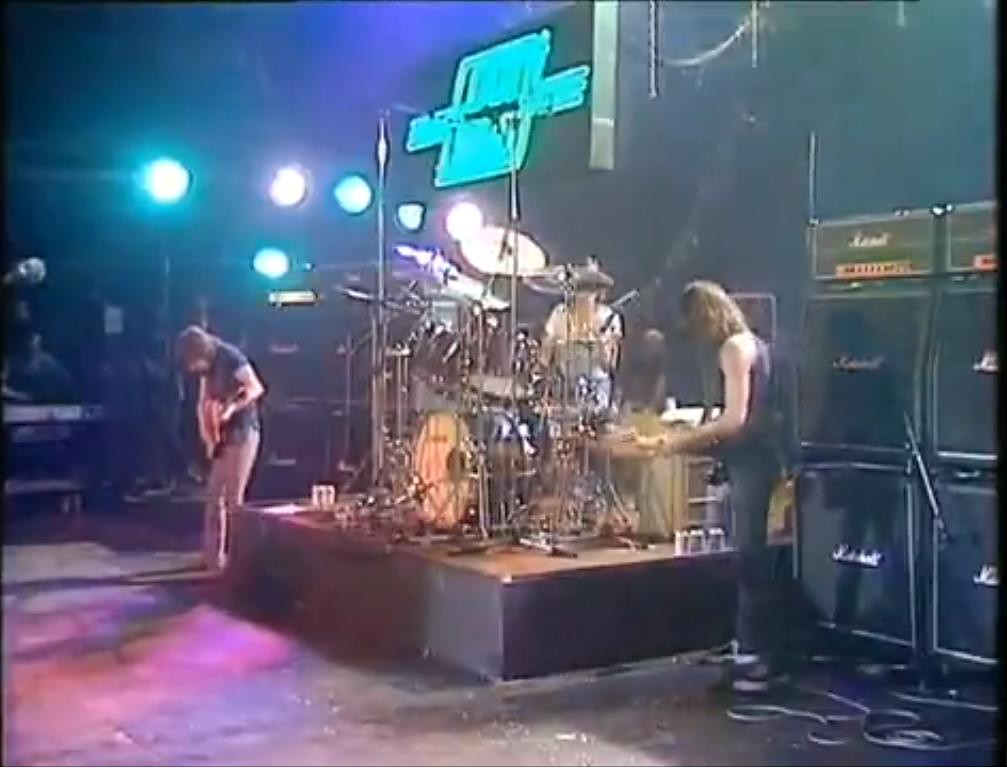 Angus’s side. There is a real wall of amps at this show
Angus’s side. There is a real wall of amps at this show
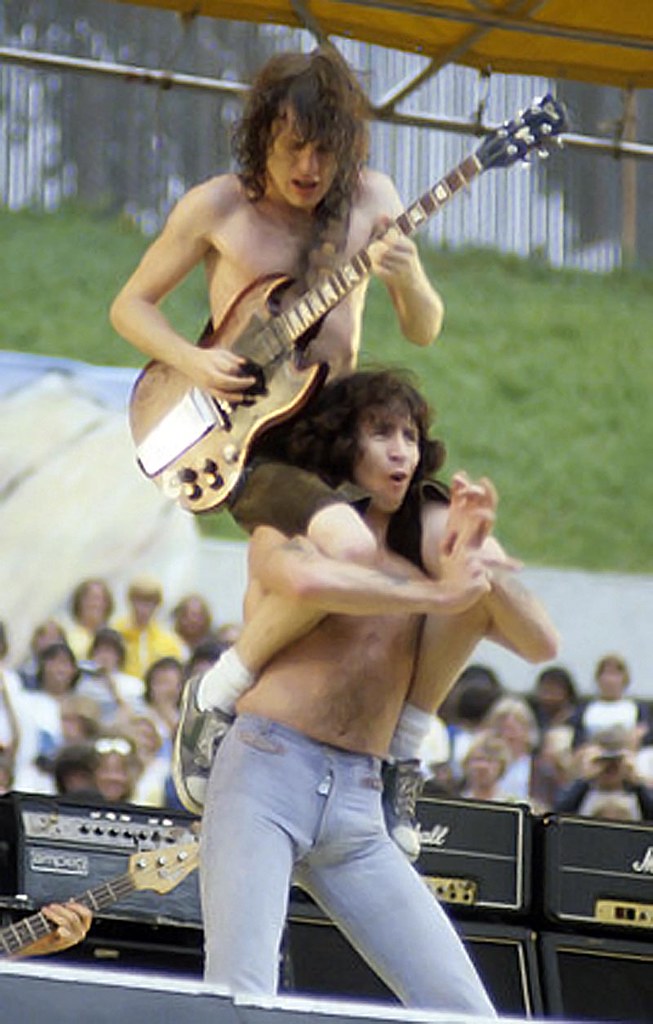 July 21st, 1979 Oakland Coliseum, Oakland, CA, USA
July 21st, 1979 Oakland Coliseum, Oakland, CA, USA
A clear shot of one of Angus’ amps
 And the other two. No comments needed.
And the other two. No comments needed.
Malcolm’s side: Two non-MV heads and the JMP combo.
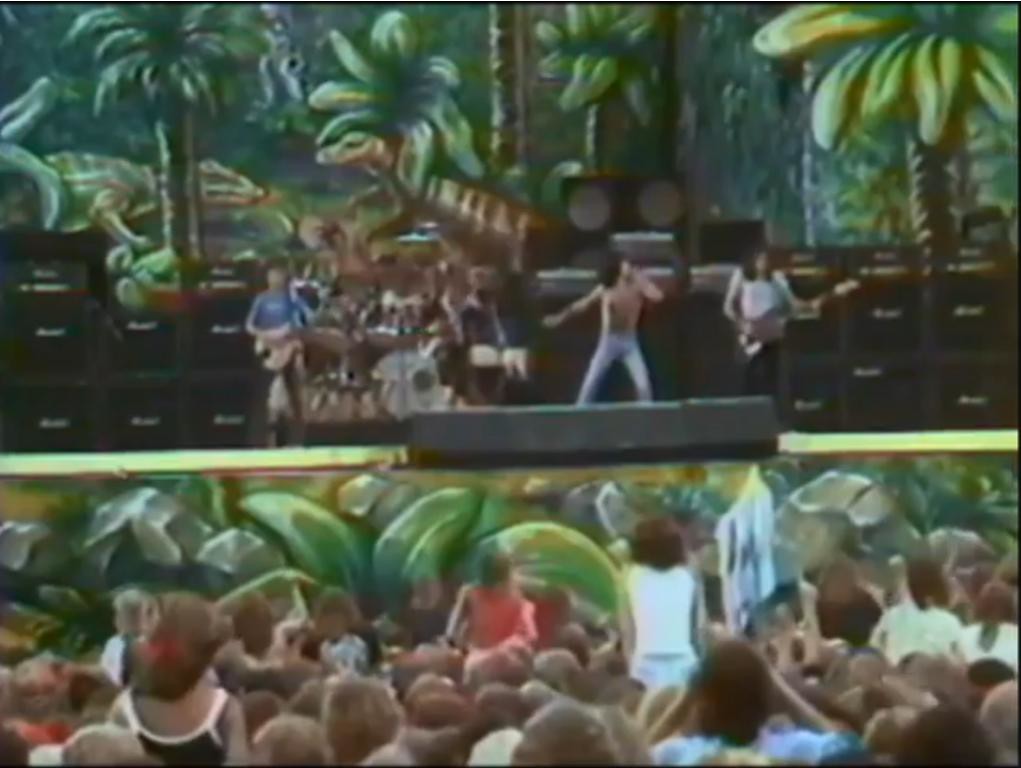 The setup is pretty much the same in all the the concerts (six amps, three for each brother). So, let’s continue.
The setup is pretty much the same in all the the concerts (six amps, three for each brother). So, let’s continue.
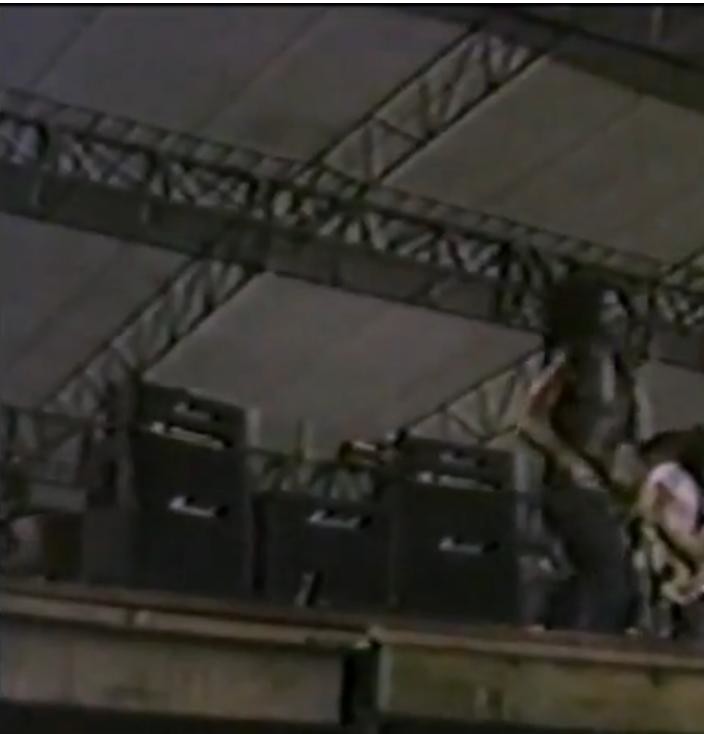 July 28th, 1979 – Cleveland Stadium, Cleveland, OH, USA
July 28th, 1979 – Cleveland Stadium, Cleveland, OH, USA
Malcolm’s amps…
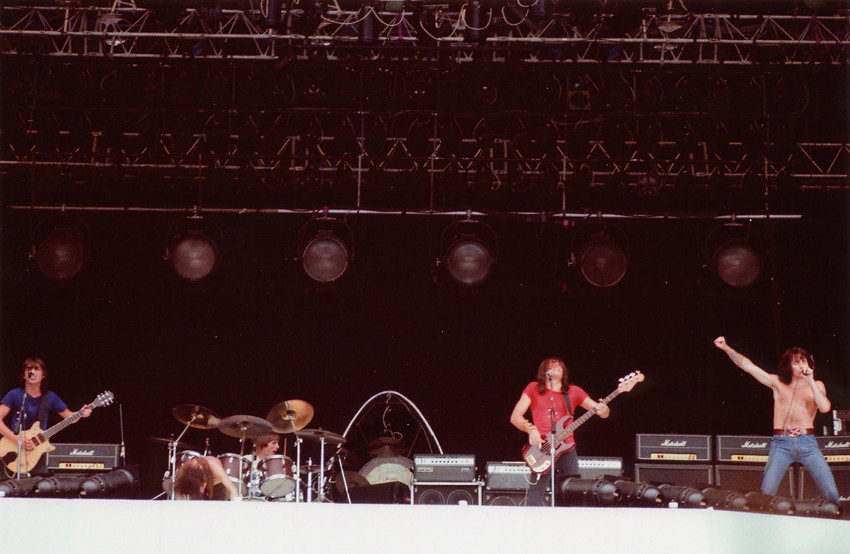 August 18th, 1979 Wembley Stadium, London, England
August 18th, 1979 Wembley Stadium, London, England
non-MV all over the place again.
 August 23rd, 1979 – Ulster Hall, Belfast, Eire
August 23rd, 1979 – Ulster Hall, Belfast, Eire

August 28th, 1979 – Rockpop TV Show, München, Germany
Looks like they really dropped the 2203s at this point. Such a small place and still using 100w eardrum-blowers
I wonder what’s so special about that combo
September 1st, 1979 – Zeppelinfeld, Nürnberg, Germany
Angus’ side (two of the three 1959 heads)
Sound examples:
As you saw, the 1979 setup is really similar to the late-1978 one. Let’s listen to some clips:
Dog Eat Dog (June 12nd, 1979 – Massey Hall, Toronto, ON, Canada)
httpv://www.youtube.com/watch?v=NObbpZ9QGPM
Bad Boy Boogie (July 13rd, 1979 – Rijnhallen, Arnhem, Holland)
httpv://www.youtube.com/watch?v=l4GnbuaKtu8
Whole Lotta Rosie (July 13rd, 1979 – Rijnhallen, Arnhem, Holland)
httpv://www.youtube.com/watch?v=VSOBEo_wSBM
Live Wire (July 21st, 1979 Oakland Coliseum, Oakland, CA, USA)
httpv://www.youtube.com/watch?v=DU0cBZ914d4&feature=related
Highway to Hell (August 28th, 1979 – Rockpop TV Show, München, Germany)
httpv://www.youtube.com/watch?v=1VRO2TJwkVM
Walk All Over You (November 12nd, 1979 – Jaap Edenhal, Amsterdam, The Netherlands)
httpv://www.youtube.com/watch?v=IuyTaEXO8Yw
Shor Down in Flames (November 12nd, 1979 – Jaap Edenhal, Amsterdam, The Netherlands)
httpv://www.youtube.com/watch?v=fFphU0-tz24&feature=related
If You Want Blood (You’ve Got it) (October 16th, 1979 – State College, Towson, MD, USA)
httpv://www.youtube.com/watch?v=6a428pJpyLM&feature=related
So… That’s basically the 1979 tone. non-MV Marshalls and Celestion G12-65, as it was in late-1978.
It is slightly less aggressive than Glasgow ’78 (guess why – MVs vs non-MVs), but just as cool, in my opinion.
NOTE: THE NEXT PART IS STILL A LITTLE UNCLEAR. WE HAVE NO ENOUGH INFORMATION TO CONFIRM ANYTHING.
The Schaffer-Vega Diversity System has a really important paper in the AC/DC sound.
The biggest proof of that is the following concert:
Shot Down in Flames (December 9th, 1979 – Pavilion de Paris, Paris, France)
httpv://www.youtube.com/watch?v=rS0_d8J4CGc&feature=related
This is really the “black sheep” of AC/DC tone.
The sound here is a lot warmer and driven. The explanation for this is that the Vega was broken or was suffering interference from a local radio. Either way, it couldn’t be used and the Young bros. had to use cables and think of another way to get the desired tone. The question now is: How did they do it?
It could be a boost with 2203 heads. But… Had they taken the MVs to France?
UPDATE: A screenshot from a Dutch TV promo of “Girls Got Rhythm”:
 Holland’s TopPop television series. November 12th, 1979.
Holland’s TopPop television series. November 12th, 1979.
 Same as above. Kinda blurry, but it’s clearly a 2-inputer. Not sure about the others, but…
Same as above. Kinda blurry, but it’s clearly a 2-inputer. Not sure about the others, but…
It seems that they were really carrying MV amps with them during 1979
And this date is really close to the Paris gig. So, it’s really probable that they were using 2203 amps on the famous “Let There be Rock: The Movie” concert.
(After all, Fil’s ears are rarely wrong!)
And a little addition:
Shot Down in Flames (November 2nd, 1979 – Hammersmitt Odeon, London, England)
httpv://www.youtube.com/watch?v=tukYw89OSP0
It sounds like the Vega is working here, right?
Angus sounds a lot brighter to me. Not as much driven though.
Now… What about the Highway to Hell album?
After some time listening to the album, I realized that the non-MV amps just CAN’T achieve that nasal and driven tone. 2203/2204 were used for sure.
Plus, Fil’s renditions of Highway to Hell and If You Want Blood are SPOT ON with his 2204 and the G12M equipped cab. So… That’s final I guess.
Also, remember that a studio is basically a small venue. Does that ring a bell?
Conclusions:
- Marshall non-MV amps apparently used through all the year (with a few MV appearences too);
- Celestion G12-65 also used extensively;
- Highway to Hell album likely recorded with (or also with) MV amps. The SVDS was used at least for lead work.
- The Young brothers sound like themselves no matter what gear they use. PERIOD.
Back in Black era (1980 – 1981)
Back in Black: The Pinnacle of AC/DC’s career. They’ve barely recovered from the shocking death of Bon and already got back to work with their new vocalist, Brian Johnson.
Now, I think this might disappoint you, but I coudn’t find a single good picture of the amps used this year! O.o
That’s because, at the time, they started to place them either next to the drums, facing the side of the stage (as seen on the Let There be Rock movie) or hidden backstage.
Let’s work with what we have then…
Look! It’s that old “mixed-up” JMP from 1977 again! Looks like they kept it. Under it we see another 4-holer.
UPDATE: I don’t know why I didn’t think of this one before!
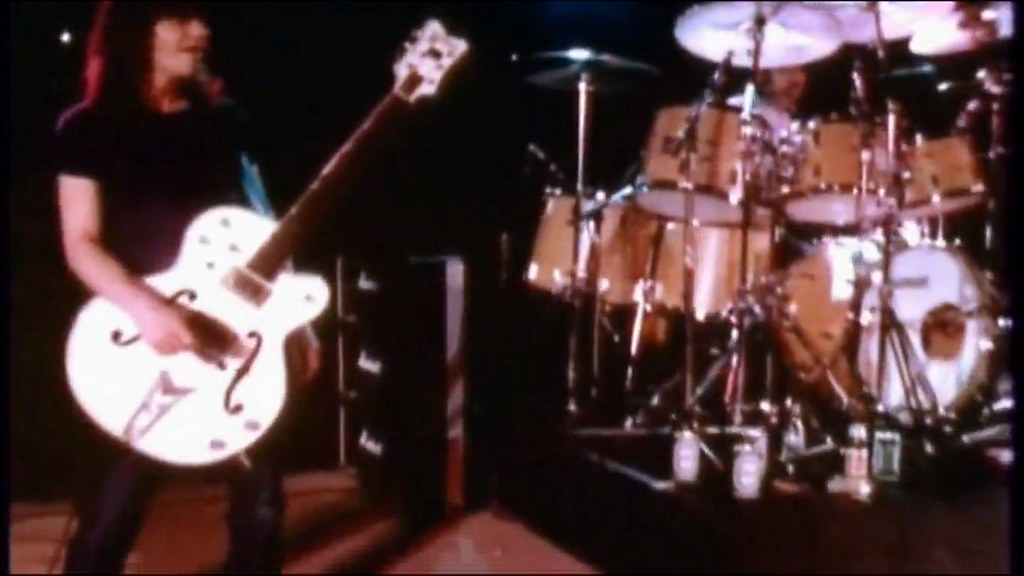 A screenshot of the promo video for Rock and Roll Ain’t Noise Pollution (July 4th, 1980)
A screenshot of the promo video for Rock and Roll Ain’t Noise Pollution (July 4th, 1980)
There we see some Marshall heads. It seems to me that they have the bigger logos used from 1980 onwards. This means they got new amps in the begining of the tour!
These are really the only pictures of the amps we have in 1980, sadly.
Now, a pic from 1981:
February 5th, 1981 – Koseinen Kin Hall, Tokyo, Japan
It’s really blurry, but you can see the amp there (luckily)
Wait… a 2203? Yeah. Seemingly (two inputs)
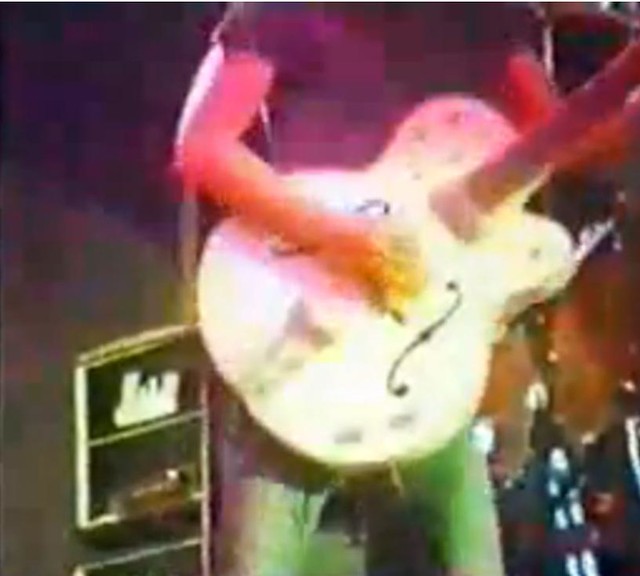 February 23rd, 1981 – Showgrounds, Sydney, Australia
February 23rd, 1981 – Showgrounds, Sydney, Australia
Another MV. Also, note the size of that logo. It’s certainly a new one.
Well… It seems that 1980 will remain as a really mysterious year… In all the senses.
Sound examples:
Since we don’t have pics, let’s work with bootlegs.
Hells Bells (July 1st, 1980 — Brielport, Deinze, Belgium)
httpv://www.youtube.com/watch?v=QVOWY3oVbsE&feature=related
Hells Bells (August 1st, 1980 – Palladium, New York, NY, USA)
httpv://www.youtube.com/watch?v=JVvZMpUR1uo
Back in Black (August 1st, 1980 – Palladium, New York, NY, USA)
httpv://www.youtube.com/watch?v=jIsrmuFlAU0
Highway to Hell (August 1st, 1980 – Palladium, New York, NY, USA)
httpv://www.youtube.com/watch?v=_x8PMDxLUig
Whole Lotta Rosie (August 1st, 1980 – Palladium, New York, NY, USA)
httpv://www.youtube.com/watch?v=KJ_Op3mgxHE
You Shook Me All Night Long (August 30th, 1980 — Dallas Convention Centre, Dallas, TX, USA)
httpv://www.youtube.com/watch?v=qBSpwTk8Jgg
Highway to Hell (August 30th, 1980 — Dallas Convention Centre, Dallas, TX, USA)
httpv://www.youtube.com/watch?v=WGVDmtbZvUY&feature=related
High Voltage (September 27th, 1980 – Cobo Hall, Detroit, MI, USA)
httpv://www.youtube.com/watch?v=UYLo0I3AvX4
What Do You Do For Money Honey (October 10th, 1980 – Civic Centre, Springfield, MA, USA)
httpv://www.youtube.com/watch?v=GTRIDT4js5s
Shoot to Thrill (November 12nd, 1980 – Hammersmith Odeon, London, England)
httpv://www.youtube.com/watch?v=7CDiHy83B-4
Whole Lotta Rosie (November 20th, 1980 – Gota Lejon, Stockholm, Sweden)
httpv://www.youtube.com/watch?v=cMJmokIWVpI&feature=related
Whole Lotta Rosie (November 29th, 1980 – La Rotonde du Bourget, Paris, France)
httpv://www.youtube.com/watch?v=K9TUh9FOEJI
Whole Lotta Rosie (December 14th, 1980 – Hallenstadion, Zurich, Switzerland)
httpv://www.youtube.com/watch?v=x7Cw0rYOVZw
What Do You Do for Money Honey (January 13rd, 1981 – Parc Des Expositions De Chateaublanc, Avignon, France)
httpv://www.youtube.com/watch?v=HT__aYoEGng
Rocker (February 5th, 1981 – Koseinen Kin Hall, Tokyo, Japan)
httpv://www.youtube.com/watch?v=q8aWdNvZIw0
Rock ‘n’ Roll Ain’t Noise Pollution (February 27th, 1981 – Myer Music Bowl, Melbourne, Australia)
httpv://www.youtube.com/watch?v=9SRdtqn681A
So… Now the question is… When did they get the new 2203 heads?
Truth to be told, I don’t know. These bootlegs aren’t really good and it’s impossible to tell the tone changes, let alone without the help of pictures.
But, I must say that the tone is really “nasal” since the very first concerts in Belgium.
UPDATE: The screenshot of the promo videos indicate that they had the new heads since the first half of 1980 – This probably means Angus used MV all through the tour too!
The Back in Black album itself is surrounded by many mysteries, stories and rumours.
Concerning the complex recording methods applied, we, here at Solodallas.com, are still trying to uncover the right elements that created the incredible, punchy and badass tone that we all fell in love with.
The photos showed many non-Master Volume heads in the rehearsal room, but we also saw a 2203 at the corner. That means they probably were using it too.
Update!
Listening to the album through headphones, I muted the left side to hear Angus and then the right side to hear Malcolm. And I realised something really important.
You know what’s so different about this album? I’ll tell you: Angus guitar alone isn’t that special (Yeah. You read right – no, I’m not nuts). Don’t get me wrong. His tone is AMAZING here, but It’s MALCOLM’S guitar that is adding all that beef! Yeah! That’s right! (I’M TALKING ABOUT THE RHYTHM GUITAR TONE HERE, BY THE WAY. Angus’ lead tone in BiB is to die for)
Remember that photo up there? The “mixed-up” JMP 2203? So… That’s it. The amps in that room probably were the ones used to record Back in Black.
And who usually plays that amp? Malcolm!
Listen to it carefully: Angus guitar is kind of thinner, more “grainy” and rawer. Malcolm’s guitar is fatter, “nasal” and brutal.
Angus played through non-MVs.
Malcolm played through a 2203!
It’s the mix of these two tones that creates such a powerful sound.
Alone, they are great. But only when the two are together, the magic happens.
Conclusions:
- Master Model amps used again on live performances (edgier sound, to match with the edgier vocals of Brian Johnson);
- Back in Black album recorded with MV amps (for Malcolm) and non-MV amps (for Angus);
- Cabinets still equipped with Celestion G12-65 speakers;
- Schaffer-Vega Diversity System still being heavily used.
- The tuning became more stable (Standard A=440), probably because of Brian’s more “technical” approach on singing.




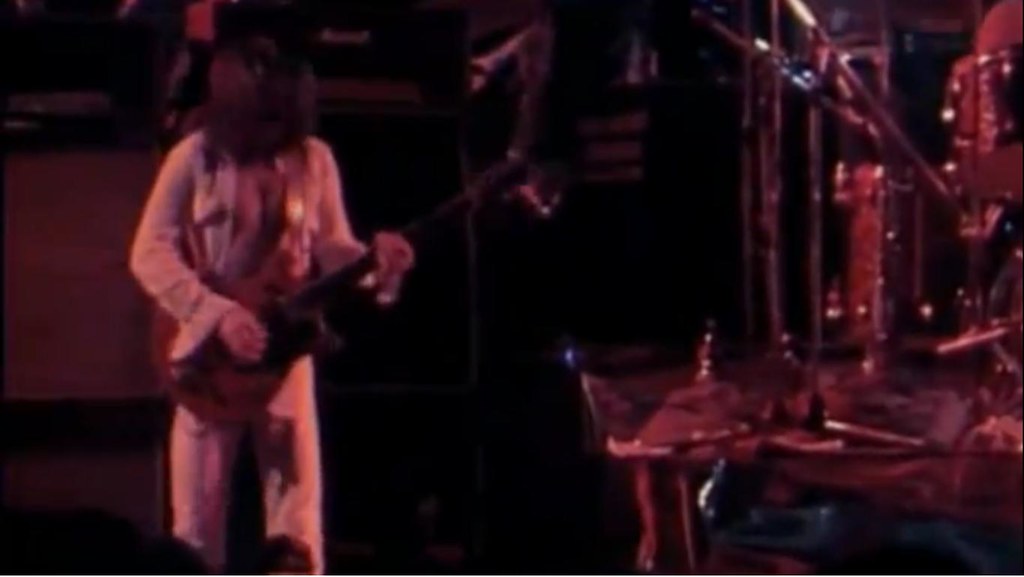
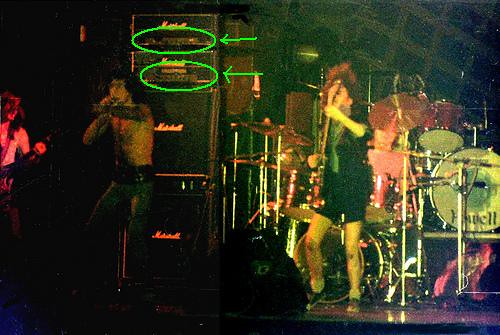
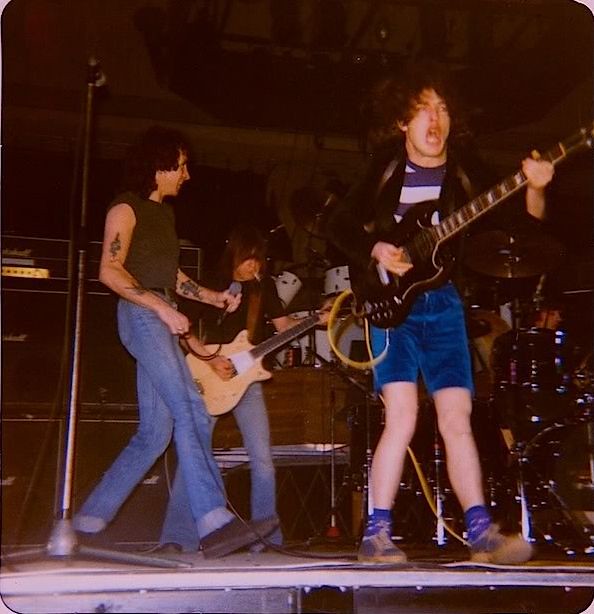
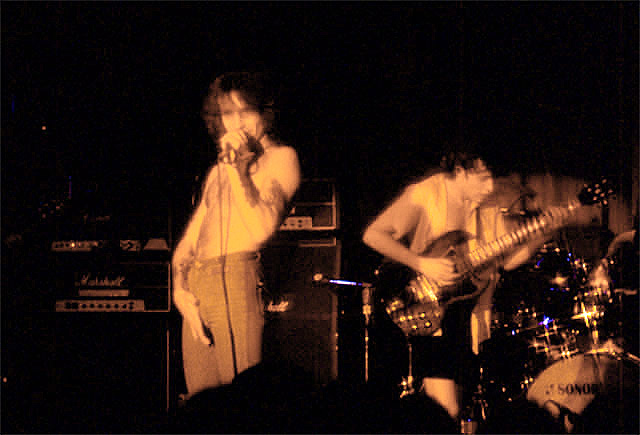

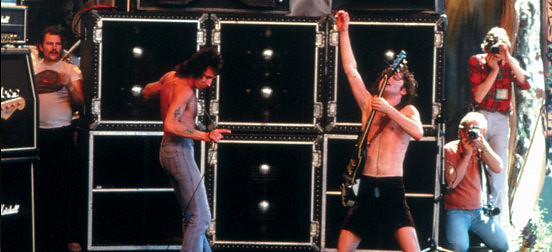
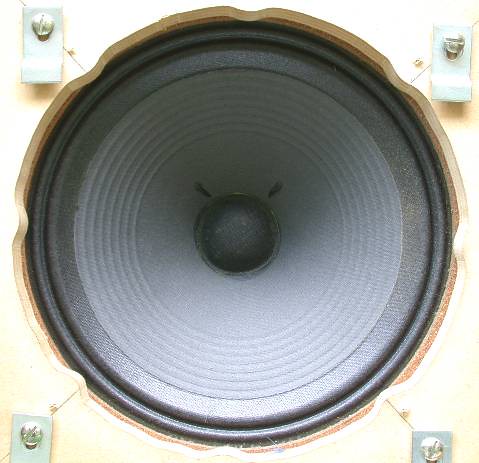
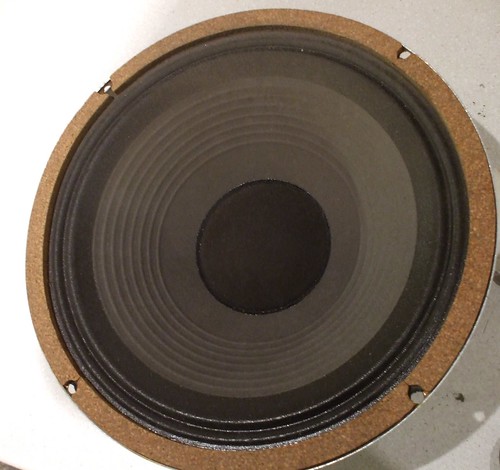
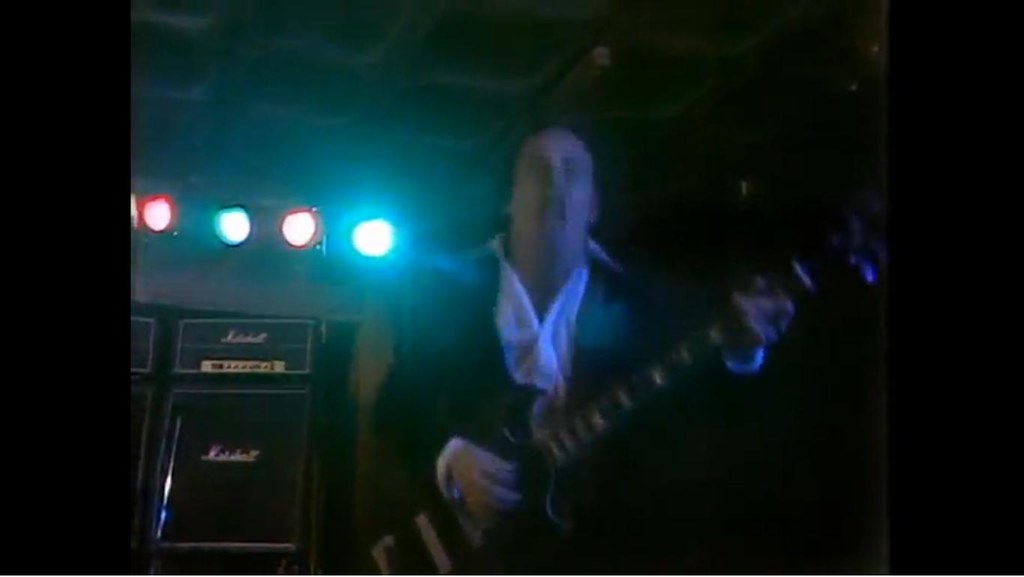

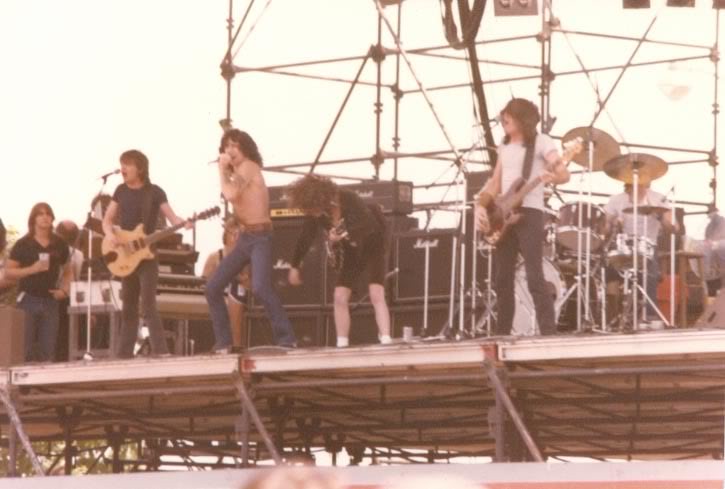

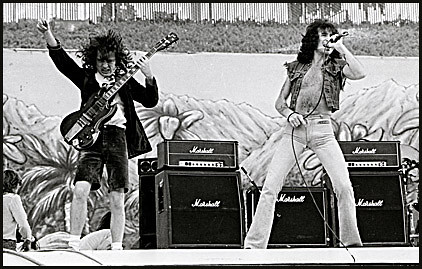



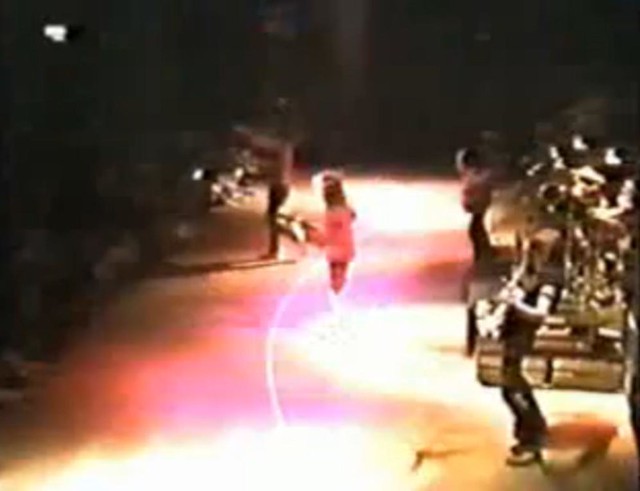
lavenderbob
Posted at 14:17h, 22 JuneSo…this may have been answered already…..but, where do you believe Malcolm and Angus placed the Master at, when they used 2203 type amps. Somewhat down to achieve a lil more pre-amp distortion, or full up to maintain a more vintage feel/sound?
lautmaschine
Posted at 22:49h, 12 AprilI’ve been thinking about Malcolm’s combo amp over the last few days. It was obviously his go to amp for a period of time, since it’s the one we mic’d up, where the other amps (whether 2003s or NMVs) are not mic’d. I guess no one knows if he was using a 2159 or a 2103, but obviously combo’s have a couple of things that are unique about them. The most obvious is the open back cabinet — that has a pretty big effect on the sound. I also just discovered something that is unique about the combos that isn’t well known. I had always assumed that the combos had identical circuits to the head versions, but I have recently discovered that amp techs mention these combos typically had a 4700pF cap on the wiper of the mid pot going to the ground. Most schematics do not show this cap — in fact I only found one schematic from a JCM-era combo that shows it. Nonetheless, it appears it was likely a common practice to use the caps on the combo amps only–through the JMP years. This cap effectively creates a low pass filter and rolls off some of the high frequencies in the tone stack before the signal goes into the phase inverter and power amp section. Anyone who has played a Gretsch with original filtertrons knows that these are bright guitars (way brighter than the average SG). So I gave it a whirl and put one of these caps on a switch with my 2204 clone. I then played my Guild equipped with a TV Jones Classic filtertron and switched back and forth. Undoubtedly this cap filtered out some of the shrill high end and made it much easier for me to dial in Malcolm’s late 70s tone.
If you want to try it yourself, all you need to do is solder a 4700pF (sometimes called a 4.7nF), with one lead on the middle lug and the other lead on the lug leading to the ground. If you do try it, let me know what you think.
Men va fan!
Posted at 20:33h, 16 AprilSo I tried it today on my 2203. The 4.7nF cap did only make a difference when cranking the middle. I want difference when middle is set to 4… So I tried a 6.8nF cap. And success! No harsh middle anymore 🙂 Thank you very much lautmaschine for this tip